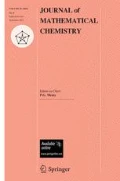Abstract
Motivated by fundamental problems in chemistry and biology we study cluster graphs arising from a set of initial states \({S\subseteq\mathbb{Z}^n_+}\) and a set of transitions/reactions \({M\subseteq\mathbb{Z}^n_+\times\mathbb{Z}^n_+}\). The clusters are formed out of states that can be mutually transformed into each other by a sequence of reversible transitions. We provide a solution method from computational commutative algebra that allows for deciding whether two given states belong to the same cluster as well as for the reconstruction of the full cluster graph. Using the cluster graph approach we provide solutions to two fundamental questions: (1) Deciding whether two states are connected, e.g., if the initial state can be turned into the final state by a sequence of transition and (2) listing concisely all reactions processes that can accomplish that. As a computational example, we apply the framework to the permanganate/oxalic acid reaction.
Similar content being viewed by others
References
Abel E.: Über den Verlauf der Reaktion zwischen Wasserstoffsuperoxyd und salpetriger Säure. Monatshefte für Chemie/Chemical Monthly 83(5), 1111–1115 (1952)
Adler S.J., Noyes R.M.: The mechanism of the permanganate-oxalate reaction. J. Am. Chem. Soc. 77(8), 2036–2042 (1955)
CoCoA Team. CoCoA: a system for doing computations in commutative algebra, Available at http://cocoa.dima.unige.it
Collart S., Kalkbrener M., Mall D.: Converting bases with the Gröbner walk. J. Symb. Comput. 24, 465–469 (2001)
Cox D.A., Little J.B., O’Shea D.: Ideals, Varieties, and Algorithms: An Introduction to Computational Algebraic Geometry and Commutative Algebra. Springer, Berlin (2007)
Deiss E.: Fachgruppensitzungen von Donnerstag, den 27. bis Sonnabend, den 29. Mai. Zeitschrift für Angewandte Chemie. 39, 664–665 (1926)
Faulon J.-L., Sault A.G.: Stochastic generator of chemical structure. 3. reaction network generation. J. Chem. Inf. Comput. Sci. 41(4), 894–908 (2001)
Harcourt A.V., Esson W.: On the laws of connexion between the conditions of a chemical change and its amount. Philos. Trans. Royal Soc. Lond. 156, 193–221 (1866)
Haus U.-U., Hemmecke R.: Unraveling the initial phase of the permanganate/oxalic acid reaction. J. Math. Chem. 48, 305–312 (2010)
Hemmecke R., Malkin P.N.: Computing generating sets of lattice ideals and markov bases of lattices. J. Symb. Comput. 44, 1463–1476 (2009)
S. Hosten, B. Sturmfels, GRIN: An implementation of Gröbner bases for integer programming. In Integer Program. Comb. Optim. pp. 267–276
Kovács K., Vizvári B., Riedel M., Tóth J.: Decomposition of the permanganate/oxalic acid overall reaction to elementary steps based on integer programming theory. Phys. Chem. Chem. Phys. 6(6), 1236–1242 (2004)
Kovacs K.A., Grof P., Burai L., Riedel M.: Revising the mechanism of the permanganate/oxalate reaction. J. Phys. Chem. A. 108(50), 11026–11031 (2004)
Kreuzer M., Robbiano L.: Computational Commutative Algebra 1. Springer, Berlin (2000)
Marwan W., Wagler A., Weismantel R.: A mathematical approach to solve the network reconstruction problem. Math. Methods Oper. Res. 67, 117–132 (2008)
Mayr E.W., Meyer A.R.: The complexity of the word problems for commutative semigroups and polynomial ideals. Adv. Math. 46(3), 305–329 (1982)
Pimienta V., Lavabre D., Levy G., Micheau J.C.: Reactivity of the Mn (III) and Mn (IV) intermediates in the permanganate/oxalic acid/sulfuric acid reaction: kinetic determination of the reducing species. J. Phys. Chem. 98(50), 13294–13299 (1994)
Shiu A., Sturmfels B.: Siphons in chemical reaction networks. Bull. Math. Biol. 72, 1448–1463 (2010)
Skrabal A.: Über die Primäroxydtheorie der Oxydationspozesse. Zeitschrift fur anorganische Chemie. 42(1), 60–86 (1904)
Szalkai I.: A new general algorithmic method in reaction syntheses using linear algebra. J. Math. Chem. 28(1), 1–34 (2000)
Author information
Authors and Affiliations
Corresponding author
Rights and permissions
About this article
Cite this article
Haus, UU., Hemmecke, R. & Pokutta, S. Reconstructing biochemical cluster networks. J Math Chem 49, 2441–2456 (2011). https://doi.org/10.1007/s10910-011-9892-6
Received:
Accepted:
Published:
Issue Date:
DOI: https://doi.org/10.1007/s10910-011-9892-6




